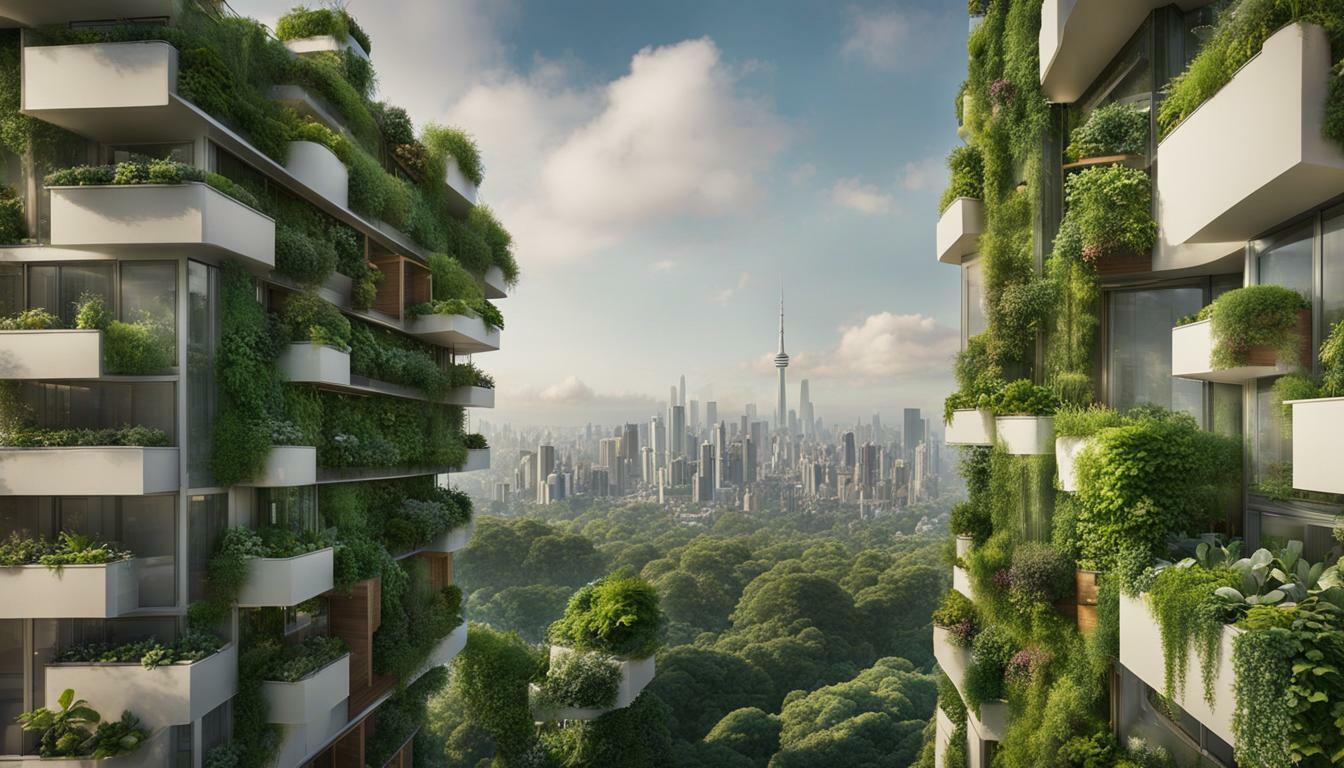Vertical Garden Apartment: A Green Living Innovation is revolutionizing the way we approach urban living by incorporating nature into our living spaces. Green architect Stefano Boeri’s vision of vertical forests has paved the way for vertical garden apartments, where lush vegetation covers the walls and balconies, creating a harmonious blend of architecture and nature. These innovative living spaces offer numerous benefits, from improved air quality to maximizing green space in urban areas. Let’s explore the world of vertical garden apartments and how they are reshaping our concept of green living.
Key Takeaways:
- Vertical garden apartments bring nature into urban living spaces, improving air quality and promoting a healthier environment.
- These innovative living spaces optimize limited space by utilizing walls, balconies, and indoor gardens, maximizing the presence of greenery.
- The tranquil ambiance created by vertical garden apartments enhances well-being and fosters a sense of serenity.
- Natural temperature regulation and the cooling effect of plants contribute to a more comfortable living space.
- Incorporating greenery into living spaces has been linked to increased productivity, focus, and creativity.
Benefits of Living in a Vertical Garden Apartment
Living in a vertical garden apartment offers a multitude of benefits, providing a breath of fresh air in our urban spaces and transforming the way we experience our living environments. The concept of vertical gardens, also known as living walls or green walls, brings nature indoors and maximizes the use of vertical space in our homes. Let’s explore some of the advantages of living in a vertical garden apartment:
- Improved Air Quality: Vertical gardens act as natural air purifiers, filtering out toxins and pollutants and releasing fresh oxygen into the air. Plants such as spider plants, peace lilies, and pothos are excellent choices for vertical gardens, as they have the ability to effectively purify the indoor air.
- Maximized Green Space: Vertical gardens allow for the cultivation of a variety of plants without taking up valuable floor space. By utilizing walls, balcony railings, or even creating a living wall indoors, you can create a lush green oasis in a limited space.
- Serene Living Environment: The presence of plants in our living spaces has a calming effect on our minds. Vertical gardens add a touch of nature to our interiors, creating a serene and inviting atmosphere. Whether it’s a living wall in the living room or a vertical herb garden in the kitchen, the presence of plants fosters a sense of tranquility.
- Energy Efficiency: Vertical gardens can help regulate indoor temperatures by providing natural insulation. The plants absorb heat and release moisture through a process called transpiration, which can help cool down the space during hot summer months. This natural cooling effect can reduce the need for excessive air conditioning and lower energy costs.
- Connection with Nature: Living in a vertical garden apartment allows us to reconnect with nature in our urban environments. The presence of greenery provides a sense of well-being, reduces stress, and boosts overall mood and productivity. It’s like having a piece of the natural world right at our doorstep.
These are just a few of the many benefits that come with living in a vertical garden apartment. The combination of improved air quality, maximized green space, and a serene living environment creates a harmonious and sustainable way of urban living.
| Image | Quote |
|---|---|
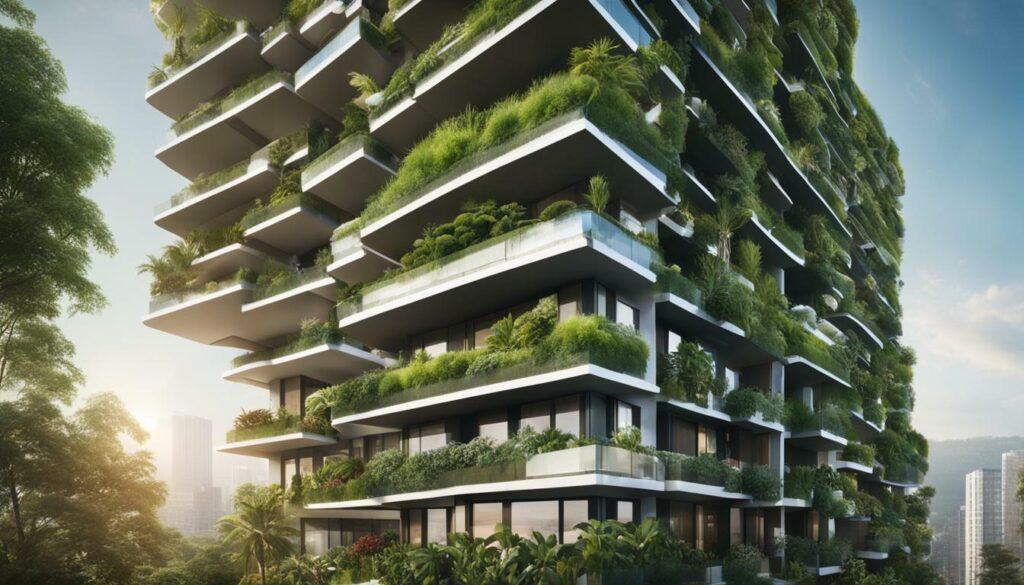 | “Living in a vertical garden apartment offers a multitude of benefits, providing a breath of fresh air in our urban spaces and transforming the way we experience our living environments.” |
With the increasing popularity of vertical gardens around the world, innovative architectural projects like Milan’s Bosco Verticale have paved the way for sustainable urban development. These vertical garden apartments not only enhance the quality of life for residents but also contribute to the overall well-being of our cities. By incorporating nature into our living spaces, we can create a greener, healthier, and more harmonious urban environment.
Design and Construction of Vertical Garden Apartments
Designing and constructing a vertical garden apartment requires careful planning and consideration, but with the right techniques, it is possible to transform any apartment into a green haven. Incorporating nature into vertical spaces not only enhances aesthetics but also promotes a healthier and more sustainable living environment for residents.
One successful example of a vertical garden apartment complex is the Bosco Verticale in Milan, designed by architect Stefano Boeri. The Bosco Verticale features over 21,000 trees, shrubs, and perennial plants, creating a lush green facade that improves air quality and mitigates noise pollution. The use of renewable energy sources and filtered waste water further contributes to the self-sufficiency of these high-rise residential towers.
Proper design and construction of a vertical garden apartment involve selecting suitable vegetation that can thrive in the specific climate and lighting conditions of the location. Green architect Stefano Boeri and botanist Laura Gatti spent considerable time and effort in choosing the right variety of plants for the Bosco Verticale, ensuring their adaptability and compatibility with the Milanese climate.
| Benefits of Designing and Constructing Vertical Garden Apartments |
|---|
| Improved air quality through the absorption of carbon dioxide and release of oxygen. |
| Noise pollution reduction due to the vegetation acting as a sound barrier. |
| Enhanced aesthetics, creating a visually appealing and serene living environment. |
| Increased biodiversity and habitat for birds, insects, and other wildlife. |
| Contributes to urban reforestation efforts and promotes sustainable development. |
It’s important to note that maintaining a vertical garden apartment requires regular care and maintenance. Proper watering, sunlight exposure, and periodic pruning are essential for the health and longevity of the plants. Additionally, incorporating sustainable practices such as rainwater harvesting and using organic fertilizers can further enhance the eco-friendliness of the vertical garden apartment.
By embracing the concept of vertical garden apartments, urban dwellers can enjoy the benefits of green living while maximizing limited space. These innovative living spaces not only provide a connection to nature but also inspire other urban reforestation projects around the world. Creating more affordable and accessible vertical garden apartments will contribute to a greener and more sustainable future for urban communities.
Case Study: Bosco Verticale in Milan
“Milan was considered a grey city, industrial, black and white more or less in the 70s and the 80s. So it’s really quite new, this amazing explosion of plants.” – Stefano Boeri
The Bosco Verticale project in Milan stands as a testament to the successful integration of nature into urban living. Designed by Stefano Boeri and Laura Gatti, this vertical forest has transformed Milan’s skyline and redefined the concept of green architecture. With over 21,000 plants, including trees, shrubs, and perennial plants, the Bosco Verticale not only enhances the city’s aesthetics but also improves air quality and promotes biodiversity.
The vertical garden apartments of Bosco Verticale provide a unique living experience for residents, offering breathtaking views of the city through the filter of lush greenery. The apartments are designed to be self-sufficient, utilizing renewable energy sources and filtered wastewater for the maintenance of the plants. The success of the Bosco Verticale has inspired similar projects worldwide, playing a crucial role in the global movement towards green and sustainable urban development.
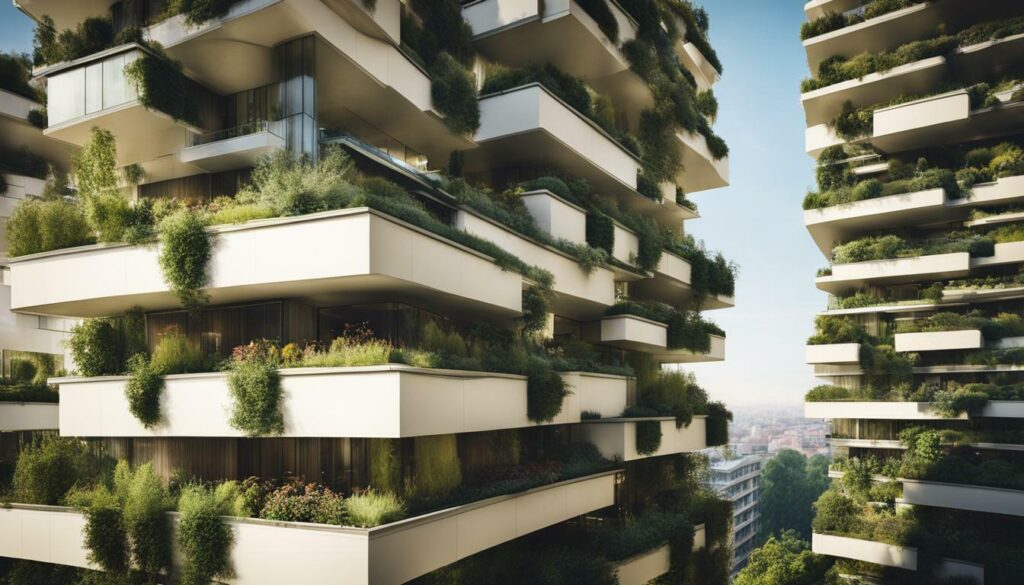
The Future of Vertical Garden Apartments
The concept of vertical garden apartments holds immense potential for the future of urban living. As cities become denser and green spaces become scarce, vertical gardens offer a solution to bring nature back into our daily lives. With advancements in technology and design, the possibility of creating vertical gardens in smaller apartments is within reach.
Urban reforestation efforts are gaining momentum, with vertical garden apartments playing a pivotal role in transforming concrete jungles into sustainable and livable environments. By providing affordable and accessible green living spaces, vertical garden apartments can contribute to a more inclusive and environmentally conscious society.
As communities strive for a greener and more sustainable future, vertical garden apartments will continue to shape the urban landscape, creating harmonious and vibrant living spaces that prioritize the well-being of both residents and the environment.
Tips for Maintaining a Vertical Garden Apartment
Proper maintenance is essential for keeping your vertical garden apartment thriving, and by following a few simple steps, you can ensure the longevity and health of your green oasis.
1. Watering: Regular watering is crucial for the well-being of your plants. Each plant species has different water requirements, so it’s important to research and understand the specific needs of your vertical garden. Monitor the soil moisture levels and adjust your watering schedule accordingly. Consider using a drip irrigation system to provide consistent and efficient watering for your plants.
2. Sunlight: Just like any garden, sunlight is essential for the growth and development of your plants. Ensure that your vertical garden receives adequate sunlight based on the plant’s requirements. Observe the patterns of sunlight in your apartment and position your plants accordingly. Use shade cloth or blinds to protect your plants from harsh sunlight if necessary.
3. Pruning: Regular pruning helps maintain the shape and health of your plants. Remove any dead or diseased foliage to prevent the spread of diseases. Pruning also encourages new growth and helps maintain the overall aesthetic appeal of your vertical garden. Use sharp and clean pruning tools to avoid damaging the plants.
4. Fertilizing: Nutrient-rich soil is essential for the optimal growth of your plants. Consider using organic fertilizers to provide the necessary nutrients to your vertical garden. Follow the manufacturer’s instructions and avoid over-fertilizing, as it can lead to nutrient imbalances and plant damage.
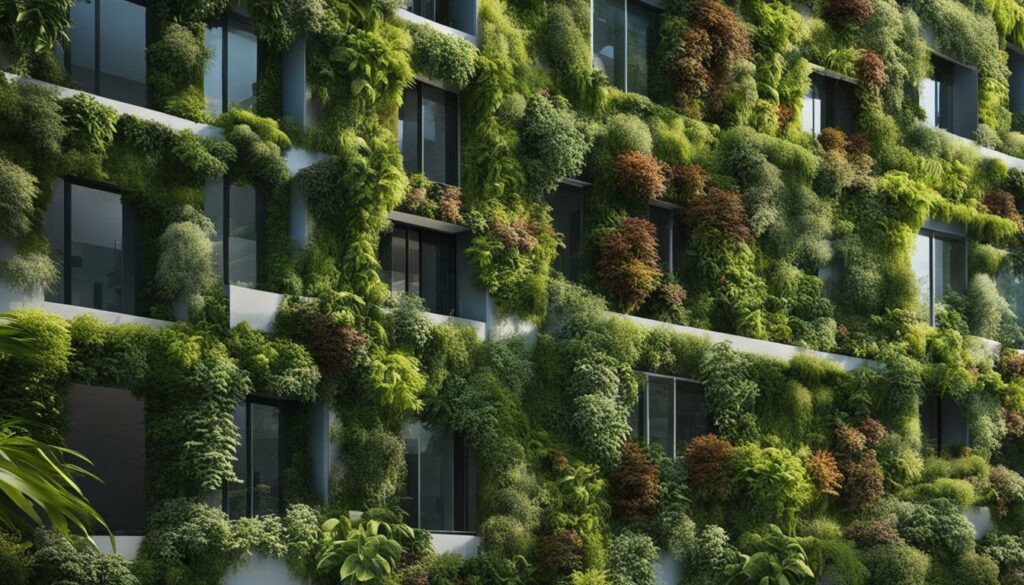
| Tips for Maintaining a Vertical Garden Apartment | |
|---|---|
| Watering | Regularly water your plants based on their specific needs and monitor soil moisture levels. |
| Sunlight | Ensure your vertical garden receives adequate sunlight based on the plant’s requirements. |
| Pruning | Regularly prune your plants to maintain shape, remove dead foliage, and encourage new growth. |
| Fertilizing | Use organic fertilizers to provide necessary nutrients, following instructions to avoid over-fertilization. |
Proper maintenance is key to keeping your vertical garden apartment lush and thriving. By following these tips, you can enjoy the beauty and benefits of your green oasis for years to come.
Expert Tip:
“Regular monitoring and attention to your vertical garden’s needs will go a long way in ensuring its success. Don’t be afraid to experiment with different plant species and combinations to find what works best in your unique living space.” – Green Architect Stefano Boeri
Urban Living with a Vertical Garden Apartment
Urban living takes on a whole new meaning with a vertical garden apartment, as it offers a unique opportunity to reconnect with nature in the heart of the city. These innovative living spaces bring the beauty and benefits of greenery into densely populated areas, transforming concrete jungles into vibrant urban oases. By integrating vertical gardens with apartment living, residents can enjoy the serenity of nature right at their doorstep, contributing to a healthier and more sustainable lifestyle.
Vertical garden apartments offer a range of advantages for urban dwellers. One of the key benefits is the improved air quality. The lush greenery acts as a natural air purifier, filtering out pollutants and releasing fresh oxygen into the surrounding environment. This not only enhances the well-being of residents but also creates a healthier and more enjoyable living atmosphere.
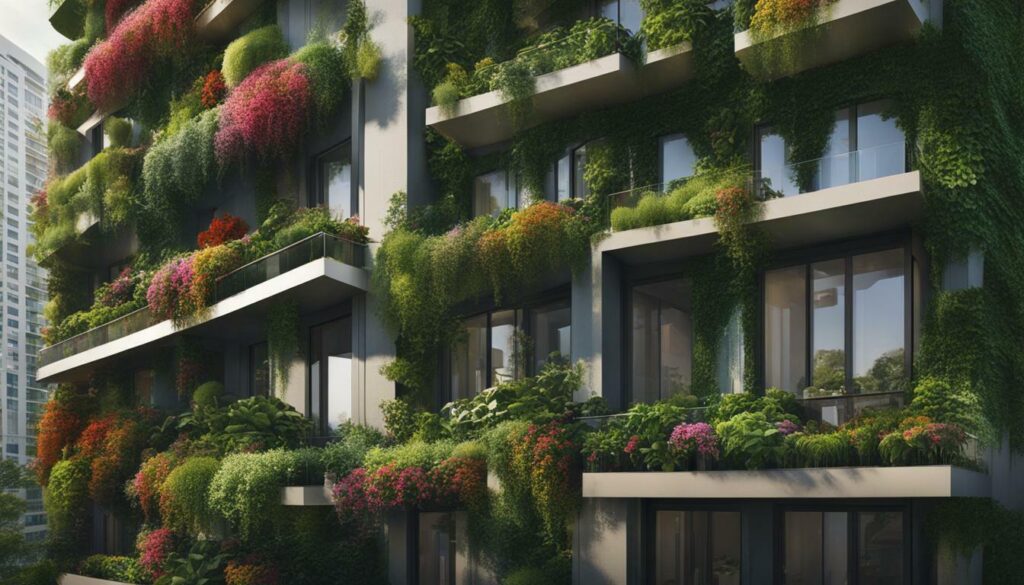
Another advantage of vertical garden apartments is the maximization of green space. In cities where open space is limited, vertical gardens provide a creative solution to bring nature indoors. By utilizing walls, balconies, and even indoor spaces, residents can cultivate a variety of plants without taking up valuable floor area. This allows for a greener and more aesthetically pleasing living environment.
Maintaining a vertical garden apartment requires proper care and attention. Regular watering, sunlight exposure, and periodic pruning are essential to ensure the vitality of the plants. Additionally, residents can create a maintenance schedule and seek professional advice to keep their vertical gardens thriving. By dedicating time and effort to maintain their green spaces, residents can fully enjoy the benefits of living in a vertical garden apartment.
Transforming Apartment Living and Inspiring Urban Reforestation Projects Worldwide
Vertical garden apartments are not only transforming individual living spaces but also inspiring urban reforestation projects worldwide. The success of projects like the Bosco Verticale in Milan has paved the way for other cities to embrace the concept of vertical gardens. These green initiatives not only enhance the quality of life for residents but also contribute to the overall sustainability and well-being of cities.
With their ability to bring nature into urban spaces, vertical garden apartments play a crucial role in creating a greener and more livable environment. As cities continue to grow and expand, the integration of green infrastructure becomes increasingly important. Vertical garden apartments serve as a model for future urban development, demonstrating the potential of combining sustainable living with architectural innovation.
Case Study: Bosco Verticale in Milan
A notable example of a successful vertical garden apartment complex is the Bosco Verticale in Milan, Italy. Designed by architect Stefano Boeri, the Bosco Verticale consists of two residential towers adorned with over 21,000 trees, shrubs, and plants. This vertical forest not only provides a stunning visual spectacle but also offers numerous environmental benefits.
The Bosco Verticale improves air quality by absorbing carbon dioxide and releasing oxygen, helping to mitigate the effects of urban pollution. Additionally, the vegetation acts as a natural sound barrier, reducing noise pollution from the city streets below. The project has received international recognition and has inspired similar initiatives around the world, further emphasizing the potential of vertical garden apartments in urban reforestation efforts.
The Future of Vertical Garden Apartments
The future of vertical garden apartments holds great promise. As the demand for sustainable and green living spaces continues to grow, there is a need for affordable and accessible options for all. One direction for future development is the adaptation of vertical gardens for smaller apartments. By implementing innovative design solutions and compact vertical gardening techniques, even those living in smaller spaces can enjoy the benefits of a green oasis.
Vertical garden apartments also have a significant role to play in urban reforestation. By incorporating nature into the heart of cities, these green spaces contribute to the restoration of urban ecosystems and the overall enhancement of the urban environment. Furthermore, initiatives focused on social housing and making green living spaces accessible to a wider audience are crucial for creating a more equitable and sustainable future.
In conclusion, vertical garden apartments offer a transformative living experience, bridging the gap between urban living and nature. As they continue to gain popularity and inspire innovative urban reforestation projects, these green living spaces pave the way for a greener and more sustainable future. By embracing the concept of vertical gardens, we can create harmonious and thriving urban environments that prioritize the well-being of both residents and the planet.
Case Study: Bosco Verticale in Milan
Bosco Verticale in Milan stands as a testament to the power of vertical garden apartments, as it has transformed the city’s skyline and become an iconic symbol of sustainable architecture. Designed by architect Stefano Boeri and botanist Laura Gatti, this innovative project features two residential towers adorned with over 21,000 trees, shrubs, and perennial plants, creating a breathtaking vertical forest.
The vegetation not only adds beauty to the city but also serves important ecological functions. It absorbs approximately 44,000 pounds of carbon dioxide annually, helping to reduce air pollution and combat climate change. Additionally, the green facades act as natural noise barriers, shielding the residents from the hustle and bustle of the city below.
Bosco Verticale is a pioneer in self-sustainable living. The towers utilize renewable energy from solar panels and recycle waste water to nourish the plant life. This innovative approach to urban living demonstrates that it is possible to create harmonious spaces that benefit both humans and the environment.
| Key Features of Bosco Verticale: |
|---|
| Award-winning design |
| Over 21,000 trees, shrubs, and perennial plants |
| Self-sufficient with renewable energy and recycled water |
| Significant carbon absorption |
| Noise reduction and improved air quality |
“It’s absolutely unbelievable the perception you have when you see the skyline of Milano through the filter of the leaves. It’s maybe the leaves of a tree that has its roots three floors below you, so it’s a really unique experience.” – Stefano Boeri, architect
Inspiring Global Urban Reforestation
The success of Bosco Verticale has inspired similar projects across the globe, with architects and city planners recognizing the potential of vertical garden apartments to transform urban landscapes. Examples include Jean Nouvel’s One Central Park in Sydney, which features extensive vertical gardens covering the walls and balconies of the building, and Vincent Callebaut’s Agora Garden Tower in Taipei, which incorporates greenery into its design to promote sustainability.
By incorporating nature into architectural projects, these vertical garden apartments not only enhance the quality of life for residents but also contribute to the overall health and well-being of urban environments. The integration of green spaces in densely populated areas helps to mitigate air pollution, reduce heat island effect, and promote biodiversity.
The success of Bosco Verticale and other similar projects emphasizes the importance of expanding urban reforestation efforts. As cities continue to grow, it is crucial to prioritize sustainable development and create living spaces that prioritize the well-being of both humans and the environment.
The Future of Vertical Garden Apartments
As the demand for green living spaces continues to grow, the future of vertical garden apartments looks promising, with potential applications in small apartments and their pivotal role in urban reforestation initiatives. These innovative living spaces offer a unique solution for urban dwellers who want to bring nature into their homes while maximizing limited space.
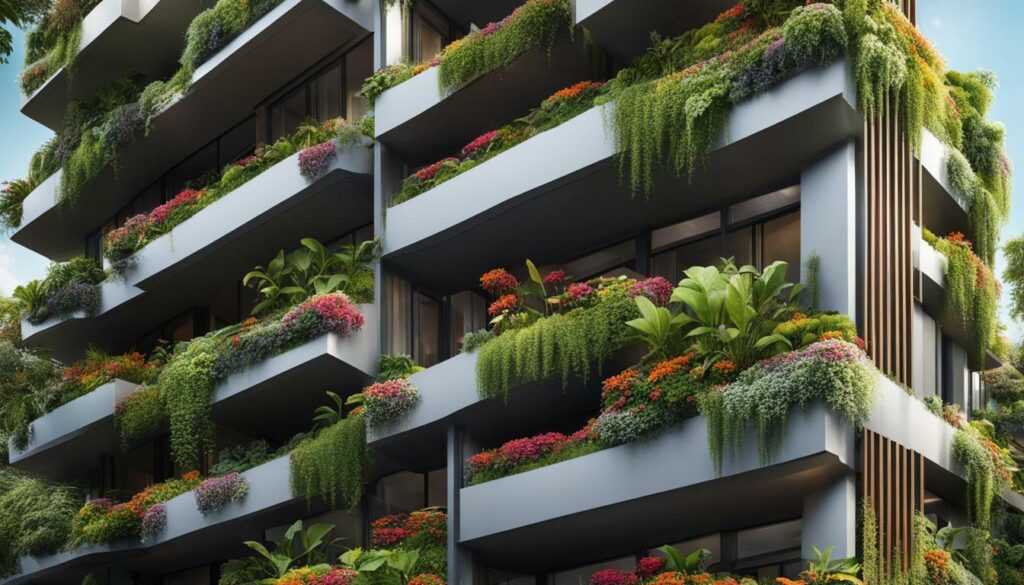
Vertical garden apartments are not only aesthetically pleasing but also have numerous environmental benefits. They help improve air quality by absorbing carbon dioxide and releasing oxygen, creating a healthier living environment for residents. Additionally, these green spaces provide insulation, reducing the need for excessive heating or cooling and promoting energy efficiency.
One of the key advantages of vertical garden apartments is their adaptability to small living spaces. With the right design and planning, even the tiniest urban apartments can be transformed into lush green oases. Vertical gardens utilize vertical space, such as walls or balcony railings, to accommodate a variety of plants, maximizing greenery in a compact area.
Urban reforestation is a crucial aspect of sustainable city development, and vertical garden apartments play a significant role in this movement. By incorporating green spaces into high-rise buildings, these apartments contribute to urban biodiversity, create habitats for wildlife, and mitigate the effects of climate change. They serve as a model for future urban reforestation projects worldwide, inspiring architects and city planners to integrate nature into urban landscapes.
The Role of Vertical Garden Apartments in Urban Reforestation
In the quest for greener cities, vertical garden apartments act as catalysts for urban reforestation. They provide a template for incorporating green spaces in densely populated areas and serve as examples of sustainable architecture and design. These living spaces demonstrate that it is possible to strike a balance between urban development and environmental preservation.
- Maximizing Limited Space: Vertical garden apartments are especially suitable for small apartments in urban areas, where space is a premium. By utilizing vertical surfaces, these apartments allow residents to enjoy the benefits of nature while conserving valuable floor space.
- Enhancing Air Quality: The plants in vertical garden apartments act as natural air purifiers, absorbing pollutants and releasing fresh oxygen. By introducing these green spaces into urban environments, air quality can be significantly improved, leading to healthier and more livable cities.
- Promoting Biodiversity: Vertical garden apartments provide habitats for various plant species, creating micro-ecosystems within the city. These green spaces attract birds, insects, and other wildlife, contributing to urban biodiversity and fostering a more balanced ecosystem.
- Reducing Urban Heat Island Effect: The presence of vegetation in vertical garden apartments helps combat the urban heat island effect, where cities experience higher temperatures due to the concentration of concrete and asphalt. The plants provide shade, cooling the surrounding areas and reducing energy consumption for cooling.
| Vertical Garden Apartments | Urban Reforestation | |
|---|---|---|
| Utilize vertical spaces to create green living areas | Integration of nature into urban landscapes | |
| Improve air quality and promote a healthier living environment | Enhancement of urban biodiversity | |
| Maximize limited space in urban apartments | Reduction of the urban heat island effect | |
| Contribute to sustainable architecture and design | Inspires future urban reforestation projects |
As cities continue to grapple with the challenges of urbanization and climate change, vertical garden apartments offer a sustainable solution that combines the benefits of nature with urban living. They demonstrate the potential for harmonious coexistence between humans and the environment, paving the way for a greener and more resilient future.
Creating an Affordable Vertical Garden Apartment
Ensuring the accessibility and affordability of vertical garden apartments is crucial in creating a sustainable and inclusive future for urban living. These innovative living spaces offer numerous benefits, including improved air quality, maximized green space, and a serene living environment. However, it is important to address the financial aspect and make vertical garden apartments accessible to a wider audience.One successful example of an affordable vertical garden apartment project is the Trudo Vertical Forest social-housing tower in Eindhoven, The Netherlands. Designed by green architect Stefano Boeri, this building contains 125 small apartments intended for low-income households. The facade of the tower is adorned with over 5000 shrubs, plants, and trees, creating a green oasis in the heart of the city. By focusing on social housing initiatives, projects like Trudo Vertical Forest make green living spaces available to those who may not have the means to afford traditional apartments with gardens.To make vertical garden apartments more affordable, it is essential to consider cost-effective construction materials and techniques. Utilizing sustainable and renewable materials can help reduce construction costs while maintaining the eco-friendly principles of vertical gardening. Additionally, implementing efficient irrigation systems and incorporating energy-saving technologies can help lower maintenance expenses in the long run.Another aspect to consider is providing education and resources on vertical gardening to residents. By offering workshops and assistance on planting and maintaining vertical gardens, tenants can learn how to take care of their green spaces effectively. This empowers them to become active participants in maintaining their vertical gardens, reducing the need for external maintenance services and further lowering costs.Investing in research and development can also lead to the discovery of new techniques and technologies that make vertical garden apartments more affordable. By continuously innovating and finding cost-effective solutions, the accessibility of vertical garden apartments can be expanded, allowing more people to experience the benefits of green living.In conclusion, creating an affordable vertical garden apartment is crucial for promoting sustainable urban development and ensuring that green living spaces are accessible to all. By focusing on initiatives like social housing, utilizing cost-effective construction materials, providing education to residents, and investing in research and development, we can make vertical garden apartments an attainable and affordable option for a wider audience. Embracing this green revolution in urban living will not only benefit individuals but also contribute to a healthier and more environmentally conscious society.| Benefits of Creating an Affordable Vertical Garden Apartment |
|---|
| 1. Increased accessibility to green living spaces for a wider audience |
| 2. Improved quality of life through the integration of nature in urban environments |
| 3. Reduction in carbon footprint and contribution to urban reforestation efforts |
| 4. Cost savings for residents through energy-efficient technologies and sustainable materials |
| 5. Empowerment of residents through education and participation in maintaining vertical gardens |
“Ensuring the accessibility and affordability of vertical garden apartments is crucial in creating a sustainable and inclusive future for urban living.”
Key considerations for creating affordable vertical garden apartments:
- Focus on social housing initiatives to make green living spaces available to low-income households
- Utilize cost-effective construction materials and techniques to reduce expenses
- Provide education and resources to residents on vertical gardening
- Invest in research and development to discover innovative and cost-effective solutions
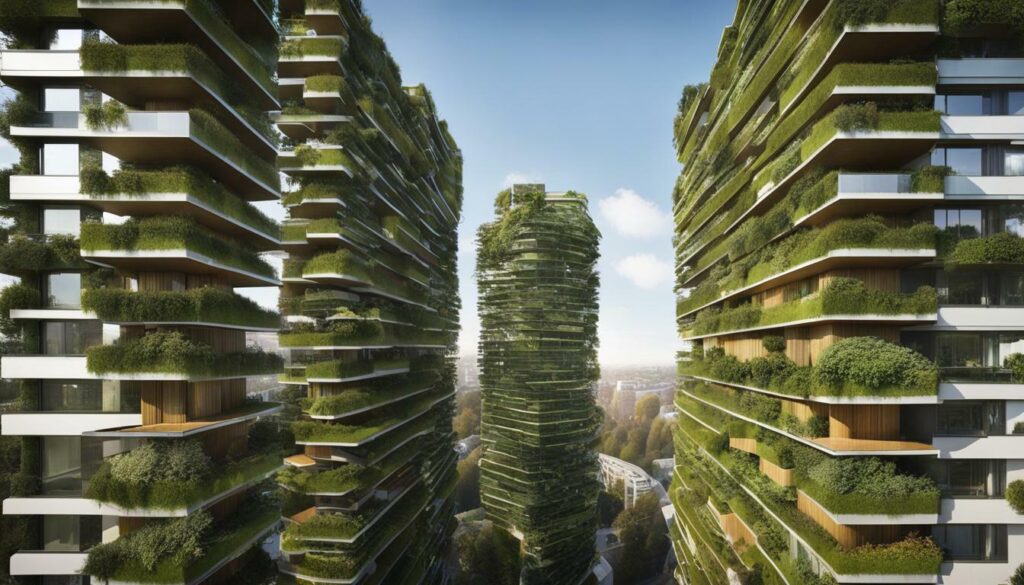 Ensuring the affordability and accessibility of vertical garden apartments is not only a matter of financial inclusivity but also a step towards creating a greener and more livable urban environment. By making these innovative living spaces attainable for a wider audience, we can foster a sustainable future where nature and urban living coexist harmoniously.
Ensuring the affordability and accessibility of vertical garden apartments is not only a matter of financial inclusivity but also a step towards creating a greener and more livable urban environment. By making these innovative living spaces attainable for a wider audience, we can foster a sustainable future where nature and urban living coexist harmoniously.Conclusion
Vertical garden apartments offer a revolutionary approach to urban living, combining the beauty of nature with the convenience of modern urban spaces, and paving the way for a greener and more sustainable future.
Architects and designers around the world are embracing the concept of vertical gardens, creating innovative living spaces that not only enhance the aesthetic appeal of buildings but also provide numerous benefits to residents and the environment. These green living spaces are transforming cities, improving air quality, maximizing green space, and creating serene and tranquil environments.
Projects like the Bosco Verticale in Milan have set the benchmark for vertical garden apartments, showcasing the environmental benefits and the positive impact they can have on urban areas. The success of these projects has inspired a new wave of urban reforestation efforts worldwide, with cities embracing the idea of bringing nature into densely populated areas.
However, it is crucial to address the challenges that come with maintaining vertical gardens. Regular maintenance and care are essential to ensure the health and vitality of the plant life. Proper watering, sunlight exposure, and pruning are all necessary to create thriving and sustainable green spaces within apartments.
As we look to the future, the potential for vertical garden apartments is vast. The concept can be adapted to smaller apartments, making green living accessible to a wider audience. Initiatives focused on affordable housing and social housing are also essential to ensure that these innovative living spaces are available to everyone, promoting inclusivity and sustainability.
In conclusion, vertical garden apartments represent a symbiotic relationship between humans and nature, offering a unique and innovative way to live in harmony with the environment. With their numerous benefits and increasing popularity, vertical garden apartments are set to play a significant role in shaping our cities and promoting green living for years to come.
How Do Vertical Gardens Improve Urban Living?
Vertical garden benefits in urban spaces are numerous. They improve air quality, reduce urban heat island effect, and provide green spaces in concrete jungles. These gardens also promote urban agriculture, encourage biodiversity, and enhance the overall aesthetics of the city. Overall, they contribute to a healthier and more sustainable urban living environment.
FAQ
Q: What are the benefits of living in a vertical garden apartment?
A: Living in a vertical garden apartment offers numerous benefits, including improved air quality, maximized green space, a serene living environment, and natural temperature regulation.
Q: How can I create a vertical garden in my apartment?
A: To create a vertical garden in your apartment, you can utilize walls, balcony railings, or even create a living wall indoors. Choose plants that thrive in vertical arrangements and consider their lighting and watering requirements.
Q: How do I maintain a vertical garden apartment?
A: Regular watering, proper sunlight, and periodic pruning are essential for maintaining a healthy vertical garden apartment. Each plant species may have specific care requirements, so it’s important to understand and fulfill their needs.
Q: How are vertical garden apartments transforming urban living?
A: Vertical garden apartments are transforming urban living by bringing nature into densely populated areas, improving air quality, and creating a serene living environment. They inspire other urban reforestation projects worldwide.
Q: Can vertical garden apartments be affordable?
A: Yes, efforts are being made to make vertical garden apartments more accessible and affordable. Some projects focus on social housing and initiatives aimed at making green living spaces available to a wider audience.
Q: What is the future of vertical garden apartments?
A: The future of vertical garden apartments looks promising, with potential adaptations for smaller apartments and their role in urban reforestation efforts worldwide. They will continue to promote green living and sustainable urban development.
Source Links
- https://www.euronews.com/green/2021/10/19/welcome-to-the-milan-apartments-where-300-humans-live-in-harmony-with-21-000-trees

- https://theconversation.com/green-buildings-can-bring-fresh-air-to-design-but-they-can-also-bring-pests-147838

- https://www.godrejproperties.com/blog/vertical-gardening-green-solutions/


